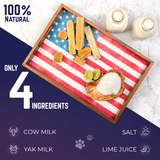Key Takeaways
- Dog jerky treats are dehydrated meat products made from one or more protein sources.
- The chewy texture and strong protein flavor appeal to dogs' natural hunting instincts.
- These treats mimic the experience of tearing and savoring fresh prey, which dogs find irresistible.
Table of Contents
- What Are Dog Jerky Treats and Why Do Dogs Go Crazy for Them?
- Types of Dog Jerky Treats: Meat Choices, Formats, and Ingredient Integrity
- Science-Backed Health Benefits of Jerky Treats (and When to Avoid Them)
- Safety Red Flags: Additives, Recalls, and the Devil Dog Vetting Standard
- Choosing the Right Jerky Treat: Sizing, Ingredients, and Chewing Styles
- How to Use Jerky Treats for Training and Enrichment (Actionable Methods)
- Store, Serve, and Rotate: Best Practices for Freshness and Safety
- Homemade Dog Jerky Treats: Step-by-Step, Safe DIY Recipes
- Dog Jerky Treats vs. Biscuits, Bully Sticks, and Chews: A Tactical Comparison
- Troubleshooting: Common Jerky Treat Problems (and Devil Dog Solutions)
What Are Dog Jerky Treats and Why Do Dogs Go Crazy for Them?
Dog jerky treats are dehydrated meat products made from one or more protein sources, offering a chewy texture and strong protein flavor that appeal to dogs' natural hunting instincts. For pet parents seeking alternative high-protein chews, bully sticks are another popular option that deliver a satisfying chewing experience.
The chewy texture and strong protein flavor appeal to dogs' natural hunting instincts. These treats mimic the experience of tearing and savoring fresh prey, which dogs find irresistible. If your dog prefers a longer-lasting chew, you might also consider an Extra Large (XL) Whole Elk Antler Official Dog Chew for extended engagement.
Types of Dog Jerky Treats: Meat Choices, Formats, and Ingredient Integrity

Meat source determines both nutritional profile and allergy compatibility. Chicken jerky offers lean protein (typically 70-80%) with moderate fat, while beef provides richer flavor but higher calories. Duck and turkey deliver novel proteins for sensitive stomachs, and fish-based jerky adds omega-3 fatty acids for coat health.
| Meat Source | Protein % | Best For | Allergy Risk |
|---|---|---|---|
| Chicken | 75-80% | Training, weight management | Common allergen |
| Beef | 70-75% | High-value rewards | Moderate allergen |
| Duck | 65-70% | Sensitive stomachs | Novel protein |
| Fish (Salmon) | 60-65% | Coat health, seniors | Low allergen |
Format affects durability and safety. Whole-muscle jerky from breast meat or tenderloin provides the cleanest ingredient list, literally "chicken breast" and nothing else. Ground-and-formed jerky combines meat scraps with binding agents, creating uniform shapes but requiring preservatives. Wrapped jerky surrounds vegetables with meat, adding fiber but increasing ingredient complexity.
Devil Dog red flags include ambiguous terms like "poultry meal," "meat by-products," or "chicken flavor", these indicate processed scraps rather than identifiable muscle meat. Quality jerky lists specific cuts: "chicken breast," "beef heart," or "duck thigh." For a deeper dive into ingredient transparency, check out this comprehensive guide to single ingredient dog treats.
Download the FREE 10-Step Dog Prep Guide
Science-Backed Health Benefits of Jerky Treats (and When to Avoid Them)
High-protein jerky delivers essential amino acids that support muscle maintenance, immune function, and tissue repair. Research shows dogs require 22 amino acids, with 10 considered essential, quality jerky provides complete amino acid profiles when made from whole muscle meat rather than processed scraps.
The chewing action provides mechanical dental benefits by scraping plaque from tooth surfaces. Studies indicate that textured chews can reduce plaque accumulation by 15-20% compared to soft treats, though jerky's effectiveness depends on thickness and chew time. Thicker strips force more jaw work and longer contact with teeth.
Avoid jerky treats if your dog has: kidney disease (excess protein taxes compromised kidneys), pancreatitis history (fat content can trigger flare-ups), or confirmed food allergies to the protein source. Dogs with diabetes need portion control since some jerky contains added sugars or glycerin.
Premium jerky fortified with omega-3 fatty acids supports coat health and joint function, while calcium-enriched varieties benefit growing puppies and senior dogs with bone density concerns. Always verify these additions through ingredient labels rather than marketing claims.
Safety Red Flags: Additives, Recalls, and the Devil Dog Vetting Standard
Between 2007-2015, the FDA received over 5,000 reports of dog illnesses linked to jerky treats, with 1,000+ deaths primarily traced to imported products from China. Symptoms included kidney failure, gastrointestinal bleeding, and Fanconi syndrome, a rare kidney disorder causing excessive urination and electrolyte imbalances. For more on veterinary concerns about jerky treats, see this Cornell veterinary public health resource.
Dangerous additives include propylene glycol (antifreeze component), artificial dyes like Red 40 and Yellow 6, and excessive sodium levels above 100mg per treat. BHA and BHT preservatives, while FDA-approved, show carcinogenic potential in laboratory studies. Quality manufacturers use natural preservatives like mixed tocopherols (vitamin E) instead.
Choosing the Right Jerky Treat: Sizing, Ingredients, and Chewing Styles

Size jerky treats longer than your dog's muzzle width to prevent gulping. A 40-pound dog needs strips at least 4-5 inches long, while toy breeds under 15 pounds require thinner, shorter pieces they can grip without jaw strain. Thickness matters more for power chewers, opt for strips at least ¼-inch thick for dogs that demolish bully sticks in minutes. If your dog is a determined chewer, the 12" Ultra Thick Bully Stick - 3pk offers extra durability for extended chewing sessions.
Quality ingredient labels read like recipes: "beef heart, sea salt" or "chicken breast." Suspicious labels hide behind terms like "chicken flavor," "meat digest," or ingredient lists exceeding eight items. Single-ingredient jerky eliminates allergen guesswork and processing concerns, exactly what dog jerky treats should deliver. For more healthy treat ideas, explore this list of top 10 healthy dog treats.
When in Doubt, Size Up, Why Jaw Safety Matters
Choking incidents occur when dogs swallow jerky pieces whole rather than chewing. A piece that fits entirely in your dog's mouth becomes a hazard. Better to trim a large piece than risk emergency surgery.
Rotate protein sources monthly to prevent food sensitivities and maintain interest. Start new proteins with quarter-sized test pieces, if your dog shows no digestive upset after 24 hours, full-sized treats are safe. Puppies need softer jerky until adult teeth fully erupt around 6 months, while seniors benefit from slightly thicker pieces that encourage beneficial jaw exercise. For puppies or seniors who need a gentler chew, Puppy Antler Chew is a great alternative.
How to Use Jerky Treats for Training and Enrichment (Actionable Methods)
Effective reward timing requires treat delivery within two seconds of the desired behavior. Break jerky into pea-sized training bits before sessions, a single strip should yield 8-10 rewards for medium dogs. Store pre-cut pieces in a treat pouch for instant access during recall or heel training.
For enrichment, stuff jerky pieces into puzzle toys or freeze them inside Kong toys with a small amount of plain yogurt. The "find it" scent game works brilliantly with jerky, hide small pieces around the yard and let your dog's nose do the work. This mental stimulation equals physical exercise for high-energy breeds.
Three Training Mistakes With Jerky: Using pieces too large (dogs focus on chewing instead of learning), giving treats without marking the behavior first (confuses cause and effect), and using jerky for every training session (reduces its high-value status). Reserve jerky for challenging behaviors like reliable recall or greeting strangers calmly.
Crate training benefits from jerky's long chew time, offer a full strip when crating to create positive associations. The focused chewing releases calming endorphins, making crate time less stressful for anxious dogs.
Store, Serve, and Rotate: Best Practices for Freshness and Safety
Store opened jerky in airtight containers at room temperature for up to 30 days, refrigerated for 60 days, or frozen for six months. Unopened packages maintain quality for 18-24 months when stored in cool, dry conditions away from direct sunlight.
Serve jerky treats as 10% of daily calories maximum, a 50-pound dog eating 1,200 calories daily can handle 120 calories from treats. Most jerky strips contain 25-40 calories, so 2-3 pieces per day fits appropriate limits. Weigh your dog monthly and adjust treat portions if weight gain occurs. For bulk treat options, see this guide to bulk dog treats.
Serve Like a Pro, 5 Fast Safety Habits: Always supervise initial chewing, remove pieces smaller than a golf ball, provide fresh water, rotate proteins, and store treats properly to prevent spoilage.
Homemade Dog Jerky Treats: Step-by-Step, Safe DIY Recipes

Making dog jerky treats at home gives you complete control over ingredients, crucial for dogs with allergies or sensitive stomachs. However, DIY jerky requires precision to avoid bacterial contamination and spoilage. If your dog has a sensitive stomach, you may also want to explore these dog treats for sensitive stomachs.
Simple Chicken Jerky Recipe: Slice 2 lbs boneless chicken breast into ¼-inch strips along the grain. Arrange on dehydrator trays or parchment-lined baking sheets. Dehydrate at 160°F for 6-8 hours, or bake at 200°F for 3-4 hours, flipping halfway through. Finished jerky should crack when bent but not break completely.
Beef Jerky Alternative: Use lean cuts like eye of round, slice against the grain for easier chewing. Same temperature and timing apply.
DIY Checklist: Top 3 Safety Musts for Homemade Jerky
- Temperature Control: Internal temp must reach 160°F to kill harmful bacteria
- Proper Storage: Refrigerate up to 1 week, freeze up to 3 months in airtight containers
- Spoilage Watch: Discard any jerky with sour smell, slimy texture, or mold spots
Storage and Serving: Homemade jerky lacks commercial preservatives, so refrigeration is non-negotiable. Break into training-sized pieces before serving, and never leave homemade treats out longer than 2 hours at room temperature.
Dog Jerky Treats vs. Biscuits, Bully Sticks, and Chews: A Tactical Comparison
Different treats serve different purposes in your dog's routine. Here's how jerky for dogs stacks up against other popular options:
| Treat Type | Protein Content | Chew Duration | Mess Factor | Best Use Case |
|---|---|---|---|---|
| Jerky Treats | High (70-85%) | 5-15 minutes | Minimal | Training rewards, quick energy |
| Biscuits | Low (12-20%) | 1-3 minutes | Crumbs | Basic obedience, low-calorie rewards |
| Bully Sticks | High (80-90%) | 20-60 minutes | Moderate odor | Extended chewing, dental health |
| Antler Chews | Minimal | Weeks to months | None | Power chewers, long-term enrichment |
| Yak Chews | High (65-75%) | 1-2 weeks | None | Moderate chewers, lactose-sensitive dogs |
Jerky's Sweet Spot: Perfect for training sessions where you need high-value rewards that won't fill your dog up or create mess. Unlike bully sticks, jerky treats don't require extended supervision, and unlike biscuits, they deliver serious protein punch for motivation. For a long-lasting, lactose-free option, try the Beast - Himalayan Dog Chew for moderate chewers.
Rotation Strategy: Use jerky for training, bully sticks for calm-down time, and antler chews for unsupervised gnawing. This variety prevents treat boredom and addresses different behavioral needs throughout the day. If your dog enjoys yak cheese, Himalayan Dog Yak Chews are a natural, protein-rich choice.
Troubleshooting: Common Jerky Treat Problems (and Devil Dog Solutions)
My Dog Won't Eat Jerky Treats: Try warming the treat in your hands for 30 seconds to release aroma, switch to a different protein source, or break into smaller pieces. Some dogs need gradual introduction, start by mixing tiny jerky bits with their regular food.
Digestive Upset Signs: Loose stools, excessive gas, or vomiting within 6 hours of eating jerky typically indicates too much too fast or sensitivity to the protein source. Reduce portion size by half and introduce more gradually. For more on the science of canine nutrition, see this recent animal science study.
Overfeeding Concerns: If your dog gains weight, calculate total daily calories from treats (should be ≤10% of daily intake) and reduce meal portions accordingly. A 50-lb dog should get no more than 2-3 oz of jerky treats daily.
Red Flags: When to Call the Vet vs. Home Fixes
Call Your Vet If: Vomiting persists beyond 12 hours, blood in stool, lethargy, or choking/difficulty swallowing
Home Management: Mild gas, slightly soft stool, or temporary loss of appetite, reduce treat portions, offer water, and monitor for improvement within 24 hours.
Download the FREE 10-Step Dog Prep Guide
Frequently Asked Questions
What types of meat are commonly used in dog jerky treats, and how do they differ in nutritional benefits and allergy risks?
Common meats include chicken, beef, duck, and fish. Chicken offers lean protein but is a common allergen; beef is richer and higher in calories; duck provides a novel protein option for sensitive stomachs; fish adds omega-3s beneficial for coat health and is low allergen.
How can I identify high-quality dog jerky treats and avoid harmful additives or low-grade ingredients?
Look for single-protein ingredients with no fillers, preservatives, or artificial additives. Choose treats made from whole-muscle cuts rather than ground or formed jerky, and always check for recalls or vet recommendations to ensure safety and quality.
What are the health benefits of feeding jerky treats to dogs, and are there any situations when they should be avoided?
Jerky treats provide high-protein enrichment that appeals to natural chewing instincts and support muscle maintenance. Avoid jerky treats if your dog has allergies to the meat source, a sensitive stomach, or if the treats contain additives; always monitor intake to prevent digestive upset.
How should I choose the right size and format of jerky treat for my dog's chewing style and safety?
Pick jerky treats sized larger than your dog's mouth to prevent choking and match the chew's durability to your dog's chewing strength. Whole-muscle jerky suits moderate chewers, while softer or smaller pieces may be better for puppies or seniors; always supervise during chewing.






